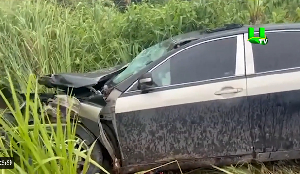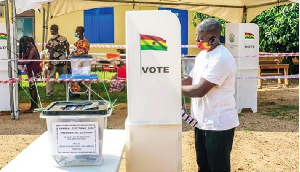Regional News of Monday, 30 October 2023
Source: Enam Deborah, Contributor
NADMO, stakeholders commend VRA’s in-depth emergency preparedness and relief support
The National Disaster Management Organisation (NADMO) and other stakeholders have commended the Volta River Authority (VRA) for its extensive preparedness and support to the affected communities in the emergency brought on by the spilling of excess water from the Akosombo and Kpong Dams.
At a press briefing hosted by the Ministry of Information in Battor, in the Volta Region, on Friday, October 27, 2023, Director-General of NADMO, Eric Nana Agyemang Prempeh, said it is commendable the extent of the Authority's efforts, including wide stakeholder consultations in its preparedness activities and their prompt response.
He was providing an update on how NADMO had handled the situation thus far, including the distribution of supplies and assistance to inundated communities.
Before the spillage:
He said that the VRA, using a data-driven approach, had strategically decided to start a controlled spill from the reservoirs to safeguard both the lives of those living downstream and the structural integrity of the dams.
Consequently, to help lessen the effects of the controlled spillage, the VRA and NADMO had planned and executed several well-coordinated initiatives with the districts that could be affected.
Among these was an exercise in May called "Exercise Da Wo Ho So 2023" which simulated the authority's emergency preparedness to make sure that all relevant parties were ready for a flood-related incident.
He stated that all stakeholders' emergency response and protocols were put to the test during this exercise and the lessons learned were identified to enhance
coordination, readiness, and responsiveness.
The Director-General clarified that to prepare all parties for the effects of the spill, NADMO and the VRA on September 9, 2023, organised district disaster management committees and wrote to the various communities who lived downstream of the dam to increase awareness of the spillage.
Furthermore, regular updates on the spillage were provided on the disaster platforms of the nine districts.
Stakeholder consultations:
NADMO’s boss noted that the VRA's Emergency Preparedness Plan (EPP) includes a thorough communication procedure to alert and educate stakeholders and the general public about the spillage and its possible consequences.
As a result, the VRA actively collaborated with NADMO and each of the nine districts that are downstream of the Akosombo Dam to improve community resilience via education and awareness campaigns.
Relief support:
Eric Nana Agyemang Prempeh further mentioned that a high-level delegation from the VRA, under the direction of its Chief Executive, Ing Emmanuel Antwi-Darkwa, and officials of NADMO carried out a quick evaluation to gather first-hand knowledge and offer prompt support.
As a result, they started extensive distribution operations that included giving relief supplies and necessities to the affected communities as well as educating the local populace about safety precautions and risk-reduction techniques. The communities affected have also been actively engaged by the Municipal and District Assemblies, who work to enable their evacuation to higher ground to guarantee their safety during the extended spill operations.
He said the combined efforts of the VRA, NADMO, and other stakeholders aimed to alleviate the suffering of the affected communities and reinforce their commitment to resilience in the face of natural disasters.
Security personnel from the various agencies were deployed to aid in the
response operations in the different communities.
The relief administration began when people started moving to safe havens on September 12; the items were positioned in the North, Central, South Tongu, and Ada East.
The VRA and NADMO provided water tankers to aid with potable water supply to those in safe havens and affected communities. The VRA further provided vehicles, buses, and trucks to assist with moving the people to various safe havens and those who wanted to relocate to their families.
According to the NADMO Director-General, both VRA and NADMO subsequently tackled the problems of electricity, water and sanitation, and mobile toilets. The Volta River Authority further assisted in building an access road from Battor to St. Kizito in Mepe, a distance of approximately 5.76 kilometres.
Continued relief administration:
Through the disaster management committees of the several affected districts and the relief administration committees of all stakeholders, NADMO, the VRA, and the associated agencies plan to continue relief administration.
These will include decontamination as the water recedes, community debris clearance, reopening schools, structural integrity assessments of the homes
and infrastructure in the affected communities, support for sustainable livelihood programmes, and other interventions. The inter-ministerial committee will decide further on additional interventions.
The NADMO Director-General emphasised that the majority of the flooding in the various districts is caused by the overflow of Black Volta in the northern part of the country and excessive rainfall rather than the VRA spillage of the Akosombo Dam.
According to him, the crisis management agency is thus conducting assessments in these areas to provide support, especially to the affected districts.
Districts in the Volta Region, including South and North Dayi, Kpando, Afadjato, Keta, and Ketu, have also received relief assistance.
These areas were inundated by spills upstream rather than the VRA's Akosombo spill. Other districts are Krachi East and West, Krachi Nchumurum, Biakoye, West and Central Gonja, and Salaga in the Savannah Region.





![Photo collage of a young and old Prof. Joseph Yaw Yeboah [Image Credit: MIT] Photo collage of a young and old Prof. Joseph Yaw Yeboah [Image Credit: MIT]](https://cdn.ghanaweb.com/imagelib/pics/697/69700645.295.jpg)





